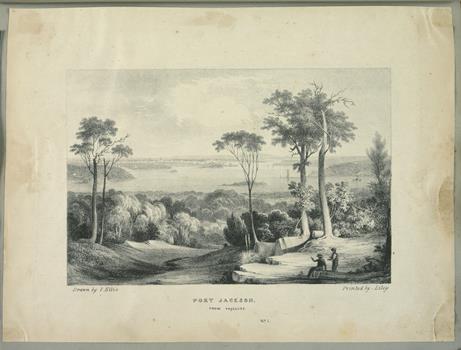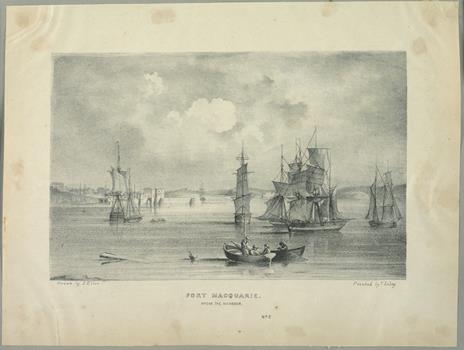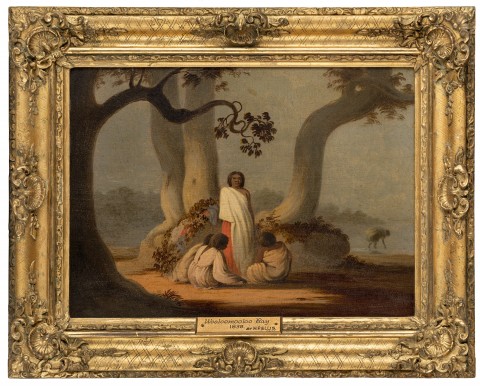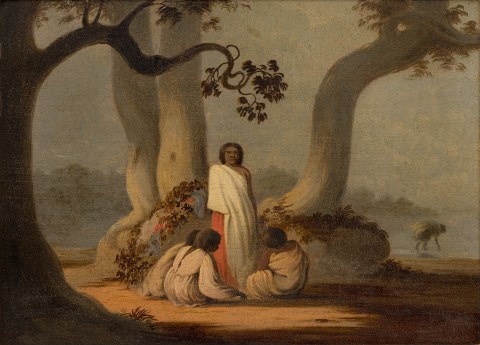WOOLLOOMOOLOO BAY, c.1838
HORACE PAYNE ELLIS
oil on cedar panel
30.0 x 40.5 cm
housed in its original ornate, gilt timber frame bearing a plaque “Wooloomooloo Bay [sic.] / 1838 / by H.P. Ellis / HEICS”
Possibly the Rev. Thomas Hassall (1794-1866)
of ‘Denbigh’, Cobbitty, NSW
Possibly Charles McIntosh (1805-1875) who leased
and then purchased ‘Denbigh’, Cobbitty, NSW
Possibly Charles McIntosh Jnr (1845-1938), ‘Denbigh’, Cobbitty, NSW
Estate of Mrs Lorna Mary Inglis (née McIntosh,
widow of Mr Richard Reginald Inglis),
formerly of properties ‘Applewood’, Cobbitty, NSW and
‘Denbigh’, Cobbitty, NSW (the latter built by
Charles Hook in 1822, purchased by the Reverend Thomas
Hassall in 1827 and purchased by Charles McIntosh in 1867)
Raffan Kelaher & Thomas, Sydney, 12 April 2021, lot 11
Company collection, Sydney
The recent discovery of Woolloomooloo Bay, 1838 has brought to light an entirely forgotten but highly significant Australian colonial artist - Horace Payne Ellis.
Very few works by Ellis appear to have survived. Two watercolours of Sydney are in the State Library of New South Wales. A lithograph of Sydney was published in the New South Wales Magazine in 1843.1 Two other lithographs, Port Jackson from Vaucluse and Fort Macquarie from the Harbour, were published separately, probably as a pair, in the same year.2 The Sydney newspaper, The Australasian Chronical, under the heading ‘News and rumours of the day’, praised both lithographs, the writer adding: ‘We hope the artist will meet sufficient encouragement to enable him to continue his Views, and thus cultivate a taste for the fine arts amidst our colonial youth.’3 Unfortunately, no other ‘views’ by Ellis appear to have been printed.
The scarcity, both of art works by Ellis and information about him, may well be due to the fact that, by mid-life, mental difficulties had brought about long-term incarceration and truncated his career. He died at the Parramatta Hospital for the Insane in 1890.
Horace Payne Ellis, the eldest child of Horace Ellis (1782 – 1830) and Mrs Philly Ellis, nee Payne, was born4 and christened in Horsham, Sussex, in 1808.5 Ellis was born into a family of successful solicitors. His father Horace ran a legal practice in Horsham, Sussex and his grandfather William Ellis (1745 – 1809) had been an attorney of His Majesty’s Court of King’s Bench at Westminster.6
Little is known of Horace Payne Ellis’ early years or education in England, though his level of skill is clearly indicative of some sort of formal art training. Certainly, he claimed to have been occupied as an artist and portrait painter in his youth. For reasons that remain mysterious, Ellis joined the Honourable East India Company’s Madras Artillery Service at an entry rank of Acting Corporal in Westminster on 10 April 1829. On his attestation papers he described his former occupation as artist. He sailed from England to British India aboard the ship Minerva, arriving in Madras on 13 August 1829.7
If a military career was in fact his family’s idea of a corrective measure to address early signs of behavioural problems, then the measure backfired. There is much to suggest that the military career of Ellis was an abject failure. By 1836, his rank had slipped to that of gunner in the 2nd Artillery Battalion. In September of that year, he faced his first East India Company court-martial at St Thomas Mount, Madras, for the alleged crime of ‘refusing to attend divine service’. Found guilty, Ellis was sentenced to twelve months’ solitary confinement.8 In mid-October 1837, he faced a second court-martial, this time for ‘disobedience and mutinous conduct’. The military court at St Thomas Mount again found him guilty, but this time he was sentenced to be executed by gunshot. His death sentence was later commuted to seven years’ transportation.9
Ellis was one of eighteen ‘European prisoners of the Crown’ transported from Madras aboard Captain Thomas Symers’ ship Caledonia on 20 August 1838. The Caledonia arrived into Port Jackson, or Sydney, on 17 December 1838. The ship’s records recorded that Ellis was thirty years-old, Protestant, single, a labourer and a soldier in the horse artillery, and that he had received multiple prison terms and hundreds of lashes as punishment during the course of his career with the Honourable East India Company.10 The ship’s records also documented his prior occupation as ‘portrait painter’ and included a judgment by his military employer of his general character as ‘bad’.11
It is not known to which master Ellis was assigned during the first years of his sentence in New South Wales. However, the fact that it was the Parramatta Bench that granted him his first Ticket of Leave Passport on 9 June 1842 and that an 1843 newspaper list of unclaimed letters gives his address as Parramatta, suggests that he had been located in or in the vicinity of Parramatta for some time.12
His first Ticket of Leave permitted Ellis to ‘travel between Sydney and Parramatta for 12 months’.13 Ellis likely made use of his earliest opportunity to travel to Sydney to make contacts in Sydney’s artistic circles. When he married freewoman Maria Sophia Ballantyne Bailey at the Scots Church in Sydney on 28 January 1843,14 his witness was Mr Raphael Clint (1797 – 1849), a surveyor, lithographer, printer and engraver of controversial reputation. At that time, Clint maintained premises in Hunter Street, Sydney.15 The exact nature of the association between Ellis and Clint is uncertain. Nevertheless, their connection indicates that Ellis intended to return to his youthful occupation as an artist.
By the time a second Ticket of Leave Passport was granted to Ellis on 10 June 1843, he had clearly expressed his professional intentions to authorities, with the result that the Parramatta magistrate formally permitted him to ‘travel though the counties of Cumberland, Camden, Cook and Bathurst following the profession of an artist for 12 months.’’16 His third and final Ticket of Leave Passport, granted by the Parramatta Bench in June 1844, intriguingly permitted him to ‘travel through the counties of Camden, Cook Bathurst and Cumberland but not through the Sydney District, following his profession of an artist for 12 months’. Why Ellis was barred from practising as an artist in Sydney at that time is not known, but perhaps behavioural issues had once again emerged as a limiting factor in his life.17
The years of the mid-1840s appear to have been artistically productive for Ellis. He shipped a case of paintings home to England in December 1845, though sadly the ultimate destination of those paintings remains unknown.18 In 1847, his painting Rocky Scenery was hung at the Australian Library in Bent Street, Sydney in the Exhibition of the Society for the Promotion of Fine Arts, the first exhibition of its kind to be held in the colony.19 Two years later, in 1849, two Ellis paintings, North Rocks20 and Landscape21 were hung in a second Exhibition of the Society for the Promotion of Fine Arts, an exhibition to which Raphael Clint also contributed with two classical intaglios of the heads of Lord Byron and von Weber.22 Other exhibitors in these exhibitions included Conrad Martens, John Skinner Prout, George Edwards Peacock, Joseph Fowles and William Nicholas.
ELLIS Port Jackson from Vaucluse.jpg

The 1840s was, however, a time of economic depression in the colony. Raphael Clint was one of its many casualties. His engraving business was declared insolvent in 1847.23 By 1850, the pressure on Ellis to make a living from his painting must have been intense and difficult and all the more necessary because by then he and his wife Maria had three small children to feed.24
There is evidence that by 1851 all was not well with Ellis. On 23 October 1851 he was arrested and imprisoned in Darlinghurst Gaol for an undocumented offence, before being discharged on bail two weeks later.25 Then on 3 January 1852 from an address in Crown Street, Surry Hills, Ellis placed a newspaper advertisement, declaring ‘The person I have married having threatened to borrow money, I hereby caution everyone against trusting her, as I will not be answerable for anything she may do.’26 Two weeks later he placed another advertisement in the Sydney Morning Herald that read ‘I hereby caution all persons against harbouring or concealing either of my children, and shipmasters, owners etc., against taking them away from the colony without my consent.’27 On January 31, 1852 Ellis was again arrested and imprisoned in Darlinghurst Gaol, but this time, no discharge on bail was made available to him. He was examined and found to be suffering from ‘mania and delusions’ and on 16 February 1852 he was transferred from Darlinghurst Gaol to Tarban Creek Lunatic Asylum.28
Horace Payne Ellis died at the Parramatta Hospital for the Insane on 29 June 1890 and was buried at the Church of England Cemetery in Rookwood.29 His widow, Maria Ellis died in Leichhardt seven years later on 7 April 1897. Incredibly, given the disaster that was her husband’s military career, her death notice in the Sydney Morning Herald described her as the ‘relict of the late Horace Payne Ellis, HEICS’. His family evidently continued to maintain a pride in their father’s association with the Honourable East India Company Service.30
ELLIS Port Macquarie from the Harbour.jpg

Horace Payne Ellis lived in an age when neither behavioural therapy nor pharmacological treatment was available to address what ailed him. His mental illness ultimately deprived him of his family, his career as an artist and his humanity. On his death certificate, the informants at the Parramatta Hospital for the Insane did not even bother to verify basic details such as the names of his parents, where he had married or how long he had been in the colony. Horace Payne Ellis, the man, had been well and truly consigned to the scrapheap.
But despite all that he had suffered, the artistic talent of Horace Payne Ellis cannot be denied. In Woolloomooloo Bay, 1838, Ellis has provided a unique vision of Sydney at the time. Woolloomooloo Bay was one of the areas where Aboriginal people continued to live, despite dispossession, dispersal and decimation from disease. Keith Vincent Smith in The Dictionary of Sydney has written: ‘Remnants of different clans banded together in mixed groups, ignoring old enmities and origins. With official encouragement, they could obtain some of the benefits of 'civilisation', such as blankets, clothing, iron hatchets and fishhooks, and bread, flour, sugar, tea, tobacco and alcohol, to which they quickly became accustomed. Their resulting lifestyle was a mixture of tradition and adaptation… [T]hese family groups searched for campsites close to the shore and near a creek or other source of fresh water [and with] access to harbour fishing… Around their fires, they could still sit naked, collect bush foods, fish and swim, tell stories and sing songs as before. When they went into the settlements to barter fish or seek supplies, they were required to put on European clothing.’31
It is interesting to speculate who the people depicted in the painting might be. The family of Bungaree (who had died in 1830) stayed in the Woolloomooloo Bay area, as did people from the Shoalhaven and other areas. The central figure bears a similarity to the Shoalhaven woman Morirang, as she is depicted in Charles Rodius’ 1834 lithograph that was made when Morirang was visiting friends in the Woolloomooloo Bay area.
Whoever Ellis has depicted in the painting, he has painted them with respect. He has also posed the group in such a formal manner that he may have been more interested in making a classical allusion rather than in documenting individuals.
Ellis’s only other known oil painting, a large copy of Nicolas Poussin’s The Triumph of Flora,32 clearly indicates Ellis’ classical training and outlook. He was no doubt wanting to paint works that would appeal to aspirational free settlers and emancipists in Sydney in the 1840s. At the Society of Fine Arts exhibitions in Sydney in the 1840s, works by local artists (including Ellis) were hung alongside works ascribed to Poussin himself, and to other old masters, from Rembrandt to Rubens. These were almost certainly imported copies but were, nevertheless, designed to reflect the sophistication and status of their owners.
In Horace Payne Ellis’s Woolloomooloo, 1838, the artist manages to capture the two, oppositional, societal views in Sydney at the time, making it a remarkable and important Australian painting that enhances our knowledge of colonial history.
1. New South Wales Magazine, Sydney, James Reading, 1843. A copy of this lithograph by Ellis is in the National Gallery of Australia.
2. A copy of each lithograph is in ‘Portraits of the Aborigines of New South Wales Sydney’, 1843, a volume compiled with the intention of publication and presented to Sir Thomas Michell – No. 6. Port Jackson. Form Vaucluse. No.1/drawn by I. Ellis, printed by T. Liley. Lithograph & No. 12. Fort Macquarie. From the Harbour. No. 2/drawn by I. Ellis, printed by T. Liley, the volume bequeathed by D.D. Mitchell, 1907, Mitchell Library, State Library of New South Wales. NB: The lithographs have ‘I’ or ‘J’ Ellis printed beneath the images. The Mitchell Library refers to I. Ellis and to J. Ellis in relation to the lithographs. Ellis preferred to be known as John and regularly interchanged John or J. Ellis with Horace Payne or H.P. Ellis. A variety of documentation confirms that these were the names of the one artist.
3. Australasian Chronical, (Sydney), 18 April 1843, p. 2 (under heading ‘News and rumours of the day’.
4. Horace Ellis (1782 – 1830) and Philly Payne (1787 – 1854) were married at the Church of St John the Baptist in Lewes, Sussex in 1807. Source: England, Select Marriages, 1538 – 1973, Ancestry.com, Ancestry.com Operations, Inc., published 2014, Provo, UT, USA
5. Ancestry.com. England, Select Births and Christenings, 1538-1975 [database on-line]. Provo, UT, USA: Ancestry.com Operations, Inc., 2014. Original data: England, Births and Christenings, 1538 – 1975. Salt Lake City, Utah: FamilySearch, 2013
6. The National Archives of the UK (TNA); Kew, Surrey, England; Court of King's Bench: Plea Side: Affidavits of Due Execution of Articles of Clerkship, Series I; Class: KB 105; Piece: 6, UK, Articles of Clerkship, 1756 – 1874, Ancestry.com, published by Ancestry.com Operation, Inc. 2012, Provo UT, USA
7. Families in British India Society (FIBIS) Database, Embarkation Lists of EIC Recruits to India, transcribed from IOR ref: L/MIL/9/100
8. Families in British India Society (FIBIS) Database, General Orders by Commander-in-Chief Transcription of Court Martial Proceedings, IOR reference L/MIL/17/417 page 273
9. Families in British India Society (FIBIS) Database, General Orders by Commander-in-Chief Transcription of Court Martial Proceedings, IOR reference L/MIL/17/3/417, page 298
10. State Archives NSW; Series: NRS 12189; item [X641]; Microfiche:735, New South Wales, Australia, Convict Indents, 1788-1842, Ancestry.com, published by Ancestry.com Operations, Inc., published 2011, Provo, UT, USA
11. New South Wales, Australia Convict Ship Muster Rolls and Related Records, 1790-1849, Ancestry.com, Ancestry.com Operations Inc., published 2008, Provo, UT, USA
12. Trove, New South Wales Government Gazette, Sydney, NSW: 1832-1900/Friday 12 May 1843 (Issue No. 40), page 651, List of Unclaimed letters for the month of April, 1843
13. State Archives NSW; Series: NRS 12204, New South Wales, Australia, Tickets of Leave, 1810-1869, Ancestry.com, published by Ancestry.com Operations, Inc, Provo, UT, USA
14. Early Church Records Marriages held at NSW Registry of Births, Deaths and Marriages, Number 3716 V74B
15. Design & Art Australia Online database and e-research tool for art and design researchers, daao.org.au, Raphael Clint Biography
16. State Archives NSW; Series: NRS 12204, New South Wales, Australia, Tickets of Leave, 1810-1869, Ancestry.com, published by Ancestry.com Operations, Inc, Provo, UT, USA
17. Ibid.
18. The Australian Journal, December 9, 1845
19. Exhibition of the Society for the Promotion of the Fine Arts in Australia, 1847, held at The Australian Library, Bent Street, catalogue printed by Kemp and Fairfax, 1847, (24pp.): Exhibit 330. Rocky Scenery, the property of Mr T.S. Mort (at SLNSW1847-1857 MRB/706/S , 706/S , FM4/9612)
20. Exhibition of the Society for the promotion of the Fine Arts in Australia. Sydney, 1849, catalogue printed by Kemp and Fairfax: Exhibit 227. North Rocks, the property of Captain McLean (at SLNSW 1847-1857 MRB/706/S , 706/S , FM4/9612)
21. Exhibition of the Society for the promotion of the Fine Arts in Australia. Sydney, 1849, catalogue printed by Kemp and Fairfax: Exhibit 381. ‘Landscape’ became the property of Mr O’Keefe (at SLNSW 1847-1857 MRB/706/S , 706/S , FM4/9612)
22. Australian Jewellery -19th and Early 20th Century by Anne Schofield and Kevin Fahy, published by Antique Collectors Club Ltd, 1992, page 166: Clint, Raphael (1797-1849)
23. Australian Dictionary of Biography: adb.anu.edu.au/biography/clint-raphael-1904
24. Amelia Ellis (1845-1920), Alfred Livesay Ellis (1848-1916) and Horace Payne Ellis (1850-1917)
25. State Archives NSW; Kingswood, New South Wales; Gaol Description and Entrance Books, 1818-1930; Series: 2523; Item 4/6304; Roll: 858, Ancestry.com, published by Ancestry.com Operations, Inc, 2012
26. Trove - The People’s Advocate and New South Wales Vindicator (Sydney, NS: 1848-1856), Monday 5 Jan 1852, page 15, Advertising
27. Trove – The Sydney Morning Herald (NSW: 1842 – 1954), Monday 26 January 1852, page 3, Advertising
28. State Archives NSW; Kingswood, New South Wales; Gaol Description and Entrance Books, 1818-1930; Item:1891; Roll:265, Ancestry.com, published by Ancestry.com Operations, Inc, 2012 & The State Records Authority of New South Wales; Kingswood, New South Wales, Australia; Returns and Reports 1845-55, 1857, 1859-1861; Series Number: 906; Reel: 746, New South wales, Australia, Hospital & Asylum Records, 1840 – 1913, Ancestry.com, published by Ancestry.com Operations, Inc. 2014, Provo, UT, USA. NB: Tarban Creek Lunatic Asylum later became known as The Gladesville Mental Hospital.
29. England & Wales, National Probate Calendar (Index of Wills and Administrations), 1858-1995 for Horace Payne Ellis, 1893 & Death Transcription from NSW Registry of Births, Deaths and Marriages: Horace Payne Ellis
30. Trove, Sydney Morning Herald, Feb 25-Jul 6, 1897, Deaths. NB: Ellis’ marriage certificate of 1843 refers to him as John Ellis, as do his military records and convict records. However, his death certificate, probate records and his wife’s death notice leave no doubt that John Ellis who married Maria Sophia Ballantyne Bailey was the same man as artist Horace Payne Ellis.
31. ‘Aboriginal life around Port Jackson after 1822’, by Keith Vincent Smith in The Dictionary of Sydney, https://dictionaryofsydney.org
32. Ellis’ recently discovered copy of Nicolas Poussin’s The Triumph of Flora (oil on canvas, 60.4 x 88.8 cm, signed ‘H P. Ellis’ lower left) has the same provenance as Woolloomooloo Bay, 1838. It is now in a private collection.
SARAH STAVELEY AND STEPHEN SCHEDING

